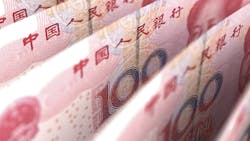The Trump administration again refrained from labeling China a currency manipulator on Tuesday, a decision that leaves one of the president’s campaign promises unfulfilled but avoids further escalation in the trade war between the world’s two largest economies.
The Treasury Department issued its semi-annual foreign-exchange report to Congress, expanding the number of countries it scrutinizes for currency manipulation to 21 from 12. Five countries -- Ireland, Italy, Vietnam, Singapore and Malaysia -- joined China, Japan, South Korea and Germany on a watch list for manipulation, while India and Switzerland were removed.
The report was officially due in mid-April but was delayed partly due to the changes to the criteria used to evaluate countries, a senior Treasury official told reporters Tuesday.
Designation as a currency manipulator comes with no immediate penalties but can rattle financial markets. Vietnam was at risk to be designated, Bloomberg News reported earlier this month, but avoided the label after officials visited Washington last week to offer more information about its currency practices.
China said Wednesday that “relevant international organizations,” and not the U.S., are in position to decide whether a country is a currency manipulator.
“The conclusion in the report that China is not a currency manipulator is in line with the common understanding of the international community,” Chinese Foreign Ministry spokesman Lu Kang said at a briefing in Beijing. “We hope the U.S. will respect market rules and not politicize the currency issue.”
Currency policy has emerged as President Donald Trump’s latest tool to rewrite global trade rules that he says have hurt American businesses and consumers. He has made foreign-exchange policy a key piece of trade deals with Mexico, Canada and South Korea, and it’s expected to be part of an agreement with China, should one be reached.
The administration last week ramped up its focus on foreign exchange, proposing tariffs on goods from countries found to have undervalued currencies. The move would let U.S.-based companies seek anti-subsidy tariffs on products from countries found by the U.S. Treasury Department to be engaging in competitive devaluation of their currencies. Currently no country meets that criteria.
As a presidential candidate in 2016, Trump often said that he would label China a currency manipulator on “day one” of his administration.
The number of countries on the U.S. watch list expanded after Treasury Secretary Steven Mnuchin lowered the threshold for qualification.
“Treasury takes seriously any potentially unfair currency practices, and Treasury is expanding the number of U.S. trading partners it reviews to make currency practices fairer and more transparent,” Mnuchin said in a statement.
Countries with a current-account surplus with the U.S. equivalent to 2% of gross-domestic product are now eligible for the list, down from 3%. Other thresholds include persistent intervention in markets for a nation’s currency, and a trade surplus of at least $20 billion.
Countries that meet two of the three criteria are placed on the watch list. China only meets one of the criteria, but Treasury says it’s on the list because of its large trade surplus with the U.S.
“Treasury continues to have significant concerns about China’s currency practices, particularly in light of the misalignment and undervaluation of the RMB relative to the dollar,” the report says.
The report comes amid an escalating conflict between the U.S. and China over everything from trade to the wireless networks of the future. Trump this month hiked tariffs on Chinese imports, accusing Beijing of backtracking on a tentative trade deal, and cut off wireless-equipment provider Huawei Technologies Co. from its U.S. suppliers.
China has said it wants a deal to end the trade war, but that it would reciprocate with counter-tariffs.
Trump on Monday said he isn’t ready to make a trade deal with Beijing. American tariffs on Chinese goods “could go up very, very substantially, very easily,” he said during a state visit to Tokyo.
The U.S. has not labeled a major trade partner a currency manipulator since 1994.
By Saleha Mohsin
About the Author
Bloomberg
Licensed content from Bloomberg, copyright 2016.
